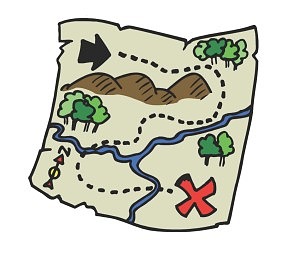The 4Cs Map: A Brain-Based Instructional Design and Delivery Model
Want an instructional design and delivery model that is easy to use? That is applicable to all the topics you teach? That is based on current brain science about how humans learn best? Here it is: the 4Cs Map.
 (Scroll to the bottom of this blog for a free 4Cs Map PDF resource).
(Scroll to the bottom of this blog for a free 4Cs Map PDF resource).
In a nutshell, the 4Cs Map is a 4-step instructional design and delivery model that is based on how human beings naturally and normally learn, NOT on outmoded assumptions about human learning. The human brain is hardwired to learn in certain basic ways, regardless of age, gender, nationality, or culture. Here is an overview of the hardwiring.
1. CONNECTIONS: The desire to learn – that is, to connect in meaningful ways to the physical environment and everything in it – is innate to the brain. For you personally, this means that, in order to learn effectively, you’ll want to connect your own past experiences and prior knowledge to the topic you’re learning about. The topic will need to be meaningful to YOU, not just to the person teaching it. And you’ll want to connect with anyone who can help you learn more about the topic – not just the “teacher,” but others who might have more knowledge or experience than you do. All this applies to the people you teach, as well.
2. CONCEPTS: As the brain immerses itself in learning, it gathers information in all sorts of ways: watching, listening, doing, trial and error, until, over time, it creates mental and physical patterns that will translate into cognition, emotion, and physical action. For you, this means you’ll try to fit any new information into the cognitive, emotional, and physical world you already know. There will be a struggle inside your brain until you can find that fit between what you already know and what you’re learning about. The same applies to those you teach.
 3. CONCRETE PRACTICE: This step goes hand-in-hand with the one before it. As the brain learns new information, it immediately begins the trial-and-error application of that information to the physical world. For you, this means that you’ll want time to practice using the information you’ve learned. You’ll learn as much from your mistakes as you will from your successes. Gradually, you’ll master what you’ve learned – and, of course, one of the best ways to master anything is to teach it to someone else. The people you instruct will need to do the same: to practice using the new information and to master it by teaching it to others.
3. CONCRETE PRACTICE: This step goes hand-in-hand with the one before it. As the brain learns new information, it immediately begins the trial-and-error application of that information to the physical world. For you, this means that you’ll want time to practice using the information you’ve learned. You’ll learn as much from your mistakes as you will from your successes. Gradually, you’ll master what you’ve learned – and, of course, one of the best ways to master anything is to teach it to someone else. The people you instruct will need to do the same: to practice using the new information and to master it by teaching it to others.
4. CONCLUSIONS: Throughout the entire learning process, the brain assesses what it has learned and how it can use the new learning in its own life. The new learning gets folded into the old, and new cognitive, emotional, and physical patterns emerge. For you, this means that you’ll do some self-reflection during this step of the learning process: evaluating what you’ve learned, how you can use it, how it will change your life, and how you feel about the entire learning experience up to now. Your feelings will also determine if you want to continue formally learning more about this topic. This self-reflection step is also important to those you teach.
Once you understand how your own brain is hardwired to learn, it is easy to use this information to instruct others. You’ll engage the learners in your class or training in various ways throughout the entire learning experience: They will create meaningful connections of their own; they’ll take in new information in multi-sensory ways; they’ll practice using this new knowledge and teach it to others; and they’ll end with some self-reflection, planning, and a feeling of satisfaction about what they learned and eagerness to learn more.
The 4Cs Map is a simple way to make sure you include all four brain-based steps in every lesson, class, or training you create. I call it a “map” because maps help us get to where we want to go. They show us where we began, where we are, and where we’ll end up. “Using a map” is a great metaphor for this 4-step instructional design and delivery model.
When you’re comfortable using all four steps to design and deliver effective instruction, you can “mess with the map” and mix up the pieces in ways that serve your learners best. You can also create “mini-maps,” that is, breaking up large instructional components/modules into smaller “mapped” segments of instruction. The 4Cs Map is an eminently flexible and versatile design/delivery tool.
If you’ve never used the 4Cs Map (or if you want a refresher), here are some great resources to get you started:
Free Micro-Courses Scroll down the page to the short, image-rich slide presentation titled: “How to Map Your Instruction in 4 Simple Steps.” Also view: “Teaching Adults Anything in 4 Easy Steps.”
Free Articles Scroll down and read the article titled: “Bag It! A Quick and Easy Way to Design Training.”
Training from the BACK of the Room! This is my definitive book about brain-based instruction and the 4Cs Map, with detailed explanations and activities for each step of this well-researched instructional design and delivery model.
For a free 4Cs Map PDF resource, click on the red button below:
************************